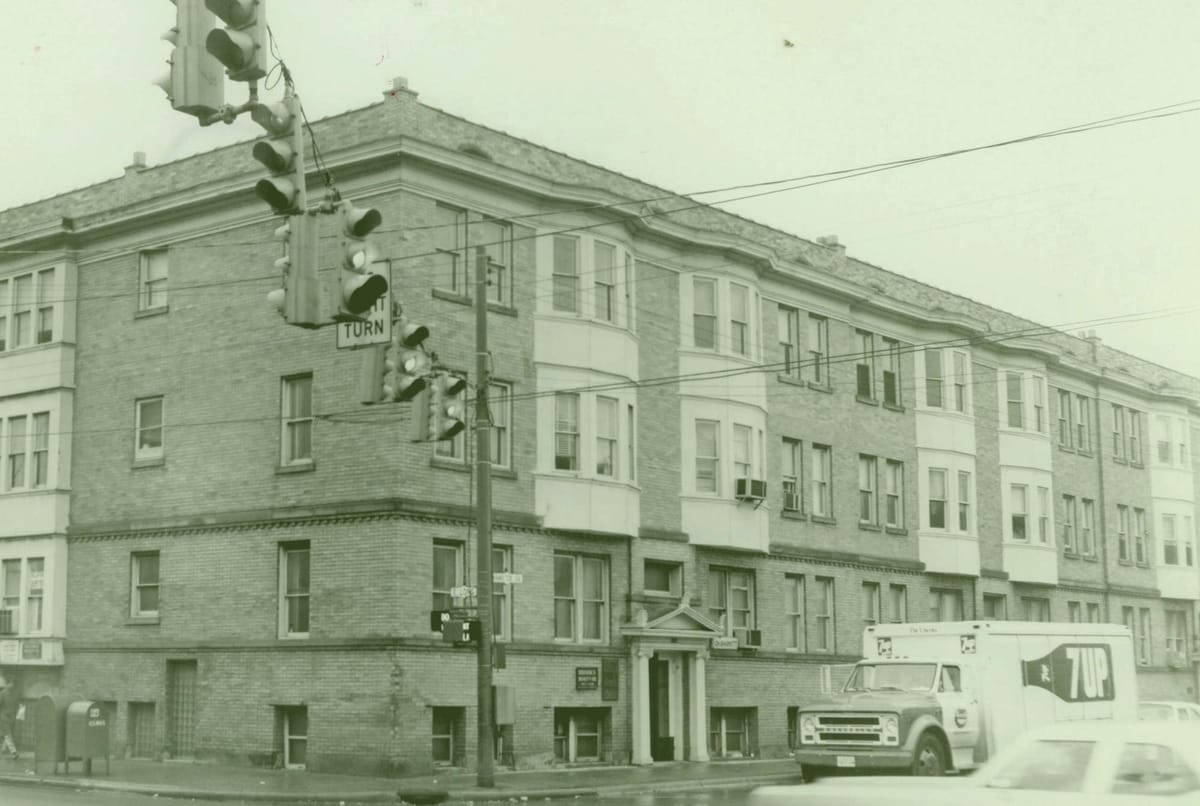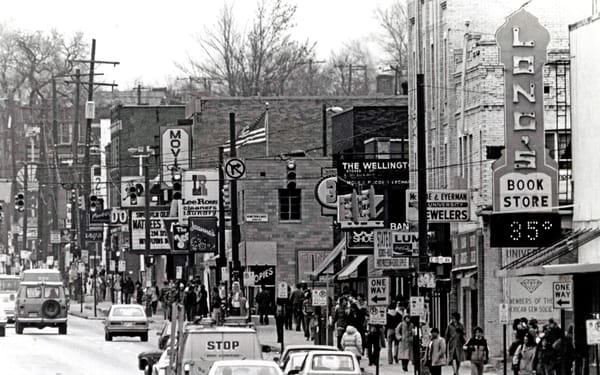'Zone In' is out! Let's discuss.
🚘 And some thoughts on government-mandated car storage 🅿️

Visit the ‘Zone In’ gallery with us on Saturday!
To learn more about phase one of the zoning code update, we’re organizing folks to attend the ‘Zone In’ gallery downtown this Saturday morning. City staff will be present to share details of the code and map, and attendees are encouraged to explore the exhibits to learn more.
When: Saturday, May 4, at 10am
Where: 141 North Front Street, Columbus
Another visit to the gallery is planned for Wednesday, May 29 at 5pm. Stay tuned for more details about this visit and other opportunities.

Residents from around Columbus gathered to learn about ways to advocate for pro-housing reforms that will help welcome new neighbors into Central Ohio.
This event, held at the Martin Luther King, Jr. branch of the Columbus Metropolitan Library, offered attendees an in-depth look at some of the most common policies to increase housing supply and stability. The group learned from community experts, area commissioners, attorneys, and a member of the ‘Zone In’ advisory committee. Thanks to all who attended!

Council will hold three public hearings in May and June regarding the proposed updates to the city’s zoning.
The first meeting is coming up next week in South Linden and will be live-streamed as well. To provide written or verbal testimony of under three minutes, email Kevin McCain by 3pm on the day of the hearing with “written testimony” in your email subject line.
When: Tuesday, May 7 from 5:30pm to 7:00pm
Where: Douglas Community Center, 1250 Windsor Ave., Columbus
Macro-level reactions to phase one of the proposed zoning code and map updates
The reforms in the ‘Zone In’ proposal resemble what cities around the country have been doing over the past few years to modernize outdated land use policy. Overall, this is a rather modest package of reforms that would create a more standardized and predictable pathway for housing production in the city.
On commercial corridors as residential sponges
Focusing on corridors, phase one will dramatically increase the potential number of units that can be built along corridors from 6,000 to 88,000 (see page 51 of the linked PDF document). In theory, leveraging the housing potential of corridors could act as a regional sponge that may reduce pressure on interior neighborhoods for additional densification.
Let’s arbitrarily say there’s an effective market demand for 30,000 housing units in the next 5 years in Columbus. If 25,000 units are built along the upzoned corridors—as part of phase one—that means only 5,000 units would need to be constructed in non-corridor areas to meet citywide demand. This isn’t how housing development works in reality due to a variety of factors—household formation, pricing issues, locational preferences, land acquisition, and parcel assemblage. Nonetheless, with many of our corridors lined with parking lots, strip malls, and obsolete, vacant, or crumbling single-story buildings, it’s easy to see the potential corridors have to house tens of thousands of new households and residents in Columbus.
On eliminating parking minimums
‘Zone In’ proposes to eliminate government-mandated parking for new construction. This move is consistent with the actions of other cities modernizing their zoning codes, and in line with thinking that points to parking mandates as one of many factors increasing the cost of new construction and consequently the cost of housing. In some markets, parking is disentangled from the cost of shelter. For example, a parking spot in a new apartment or condo building might cost upwards of $20,000, but that space could be bought and likely resold at a higher price when the resident moves. But this means that the cost of housing itself is generally independent from whether the unit has a parking spot.
In Central Ohio, however, most apartments do not charge parking fees. This is not the case universally, but in the region overall most tenants do not pay a parking fee, which means the cost of rent is usually wrapped up with the cost of setting aside land on the site for parking (meaning there are fewer units) and maintaining a parking lot. As such, the cost of parking and private vehicle ownership is spread equally among all households in apartment communities—even those that do not own vehicles.
This is part of the rationale for eliminating government-imposed parking minimums. If the cost of housing and the cost of storing private vehicles can be disentangled, it would at least help itemize these costs as distinct and potentially reduce the cost of housing.
The idea that government should force property owners to make concessions in their development plan to accommodate the mode of transportation of their potential customers is rather unique. Traditional site development has been about developing a site—not addressing weaknesses in regional transportation. Moreover, eliminating government-imposed parking requirements will not eliminate parking. It will just mean that government won’t be forcing property owners to set aside valuable land specifically for their car-owning customers. Instead, the developer and their financing partners will make this determination. As the BIA indicated in a recent Dispatch editorial, it’s unlikely developers will pursue many projects without any parking.
Jon Melchi, executive director of the Building Industry Association of Central Ohio, told the Dispatch that it is "highly, highly unlikely" that developers would build without parking.
"This market is still a driving market and tenants would demand it and those financing the project would demand it," he said.
Despite this reality that parking won’t disappear as a result of this policy shift, it’s still incumbent upon the city to end this public policy of mandating private car storage on development sites where housing would be more prudent. Instead of asking private property owners to address regional transportation deficiencies, we should promote a comprehensive regional transportation system that offers safe and reasonable options to individuals. After decades of dismantling hundreds and hundreds of miles of rail infrastructure in Central Ohio, it’s time to shift away from our singular dependence on cars and allow people choice.
The recent Dispatch editorial, which encourages Columbus residents to get involved in ‘Zone In’, also touches on parking.:
One of the more controversial aspects of the zoning code update is the elimination of all parking requirements. Officials say allowing developers to choose how many spaces to develop will follow the lead of a list of cities that includes Minneapolis, Chicago and Austin, Texas.
Despite the wide precedent for ending parking minimums, as well as agreement among transit advocates, housing activists and other constituencies, there are those who believe local government should still force property owners to accommodate the storage of their chosen mode of transportation on-site.
An April 19 letter to the editor wondered how neighborhoods would fare after this change, while predicting that developers will immediately build “too tall apartment buildings” in neighborhoods throughout Columbus (despite the fact that phase one addresses corridors only).
…unleashing of developers on neighborhoods to be flooded with cars left by residents of too tall apartment buildings with too little parking?
This complaint of the editorial is largely incorrect, as residents of new apartments built in, say Italian Village and Weinland Park as examples, are not eligible to purchase city permits for on-street parking. Thus, they wouldn’t be flooding public streets with private cars. Comments like this are likely to continue—pitting existing residents against the specter of new apartment-dwellers. Nonetheless, the elimination of parking minimums is sound policy. Regional transportation deficiencies should not be solved through housing policy.
On incentives and the affordability density bonus
To our understanding, the ‘Zone-In’ proposal does not impact the city’s current tax incentive structure for development (please correct us if we’re mistaken). Some opponents have characterized the update as a “giveaway” to developers—without any concrete explanations of how exactly this is the case. On the contrary, the proposal includes a crucial affordability component that will incentivize mixed-income housing by allowing developers to build more units if they offer below-market-rate units. But again, the zoning code update does not alter the city’s current tax abatement policy (check out the map of Community Reinvestment Areas).
The update includes provisions that allow a density bonus if developers include some housing units at below market rents to tenants. For example, in the ‘Urban Center’ zone, a developer could build a five-story building without any units below market rate. But if they include some units at below market rate, they could build up to seven stories without a variance (see page 13 of the proposal PDF).
Preliminary thoughts on a few aspects
- The proposal does not have much detail about the affordability thresholds and there could be some increased attention scaling the density bonuses to allow for deeper affordability in exchange for more allowable stories.
- Consider provisions that tie rent increases (even market rents) to an inflation index for 20 to 30 years in exchange for density bonuses.
- Consider incentivizing developers/property managers to use a standard lease agreement in return for affordability. This would ensure transparent and fair landlord-tenant contracts and work to prevent litigation from tying up courts.
- Disclaimer: Without legal expertise, it’s difficult to know how housing policy goals like affordability and tenant stability can be realistically achieved through a zoning code—so these issues may need to be addressed outside of land use.
These are just some initial reactions—we’re still processing this long document.
Don’t hesitate to get in touch if you want to discuss any particular portions of the document or strategize about advocacy. Stay tuned for more detailed reactions and recommendations to the proposed updates to the code and map.
🗞️ Fresh + Stale Links 🏘
Local + Regional 🌳
- 'We have run out of housing': Homelessness is at an all-time high again in Columbus
30 April 2024, The Columbus Dispatch - Eviction filings at 20-year high in Columbus, Franklin County and set to worsen.
24 April 2024, The Columbus Dispatch - OSU-area plan would replace Bier Stube with nation's second-tallest wood-framed building21 April 2024, The Columbus Dispatch
- Ohio senate committee releases 2024 housing report
18 April 2024, Spectrum News 1 - Ohio bill would incentivize cities to encourage affordable housing
17 April 2024, Dayton Daily News - New owner gives entire Northeast Side apartment complex 90 days to get out
17 April 2024, The Columbus Dispatch - State leaders say actions need to be taken on supply, cost of housing in Ohio
17 April 2024, WBNS 10TV - Ohio housing report shows crisis, bipartisan group of lawmakers propose solutions17 April 2024, News 5 Cleveland
- Columbus Metropolitan Housing Authority board approves $25 million in housing investments
17 April 2024, Spectrum News 1 - 'House hacking' is Gen Z's new approach to home buying: What is it?
16 April 2024, The Columbus Dispatch - Zoning is not sexy until developers eye your neighborhood. Columbus must get it right now.
15 April 2024, The Columbus Dispatch (Editorial) - Affordable housing project unveiled in Weinland Park
11 April 2024, The CW Columbus (WSYX) - How zoning code proposal could impact affordable housing in Columbus
5 April 2024, WCMH NBC4 - Only 1/4 of Columbus families in need of affordable housing can get it
1 April 2024, The Columbus Dispatch - First-time buyers dominate Ohio housing market
26 March 2024, Axios Columbus - Unlivable Latitude Five25 apartments listed for sale, seeking major rehab
22 March 2024, WCMH NBC4 - What new Realtor ruling means for Columbus home buyers, sellers
19 March 2024, The Columbus Dispatch - Columbus area's housing crisis 'a five-alarm fire.' Beyond time for a regional response.
18 March 2024, The Columbus Dispatch (Editorial)
National 🇺🇸
- Law that ended single-family zoning is struck down for five Southern California cities
29 April 2024, Los Angeles Times - New Washington law authorizes tax breaks for affordable housing built on state land15 April 2024, The Spokesman Review
- Lawsuit Alleging Racial Bias in Home Appraisals Is Settled
25 March 2024, The New York Times - Biden Suggests a Bigger Federal Role to Reduce Housing Costs
21 March 2024, The New York Times - What Comes Next for the Housing Market?21 March 2024, The New York Times
- AOC and Sanders aim to place public housing at center of Green New Deal
21 March 2024, The Guardian - America’s Magical Thinking About Housing
21 March 2024, The Atlantic - How evictions and housing instability can have deadly consequences
21 March 2024, PBS Newshour - White House targets local zoning restrictions in push to address rising housing costs
21 March 2024, The Hill - DOJ escalates price-fixing probe on housing market
20 March 2024, Politico - Boston’s Mayor Makes Friends—and Enemies—with Her Focus on Housing
20 March 2024, The New Yorker - How Does Paris Stay Paris? By Pouring Billions Into Public Housing
17 March 2024, The New York Times - Powerful Realtor Group Agrees to Slash Commissions to Settle Lawsuits
15 March 2024, The New York Times - The Surprising Left-Right Alliance That Wants More Apartments in Suburbs
9 March 2024, The New York Times




